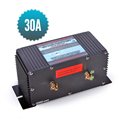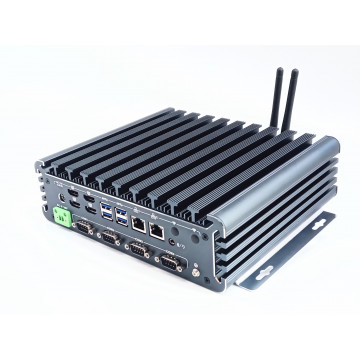
- New
- All TZ Pro software (4 displays via HDMI)
- Intel Core i7 1255U (1.7 - 4.7 Ghz) 12th Gen
- DDR4 32 GB
- 500 GB SSD
- W10 pro
- 9 to 36 V
- Power consumption: 7 to 60 W
- 230x200x68 mm (L x W x H)
- 2.64 kg
- 2-year warranty
 CATALOG AND PRICE LIST
CATALOG AND PRICE LIST
 ENERGY
ENERGY
 COMPUTER SCIENCE
COMPUTER SCIENCE
 INSTALLERS
INSTALLERS
 BLOG CONSEIL
BLOG CONSEIL
New products



| Function | Prevents galvanic leakage currents that occur on shore when the boat is connected via the earth connection. In the event of a fault in the on-board circuit, the earth connection continues to have an effect in protecting the users. This product is very easy to install and complies with the CE EN ISO 13297 standard. |
|---|---|
| Max current | 30A |
| Dimensions | 220*120*100mm |
| Weight | 1.5kg |
The galvanic isolator isolates your boat from other metal masses that would naturally be connected via the ground cable when your boat is connected to the dock. This allows in particular your sacrificial anode to be consumed only for the needs of your boat and prevents its premature wear.

In order to comply with the latest EC regulations (in particular the EN ISO 13297 standard), boat builders are now required to connect the earth to all metal grounds of the boat which is also connected to the submerged anodes. This ensures that in case of a problem on the AC circuit, the differential circuit breaker will work and guarantee the safety of the users.
However, this creates a new problem, in that via the ground cable, your boat is connected to all the other surrounding metal masses (especially those of neighboring boats) via the ground connection.
This creates two main problems:
These currents can more or less quickly destroy metal equipment placed below the waterline (your boat acts as an anode for the neighbor's). Zinc anodes can prevent this phenomenon, but they often prove insufficient when boats are left on the pontoon for a long time.
The solution to this problem is to install a galvanic isolator which ensures the continuity with the ground necessary for your protection but avoids the continuity with the dockside plug to prevent corrosion (prevents leakage currents).
The salt water in which the boat is immersed is naturally conductive of current. At the chemical level, all the immersed parts of the boat are therefore immersed in the same electrolyte (conductive solution containing ions that can transport current).
The most common phenomenon is galvanic corrosion which occurs naturally within the boat: When two metals are in contact and are immersed in an electrolyte, a chemical pile is formed. The less noble metal is oxidized and deteriorates. In order to prevent this problem when two metals of different nature are in contact (bronze propeller and stainless steel propeller shaft for example), a sacrificial anode is put in place. If this anode is consumed, the two metals forming the part react with each other. In the above case, if only bronze and stainless steel remain, it is the bronze part that will deteriorate.
Note that the oxygenation of the water has a determining role in the speed of the reaction (boats located near locks or in an area close to a highly oxygenated dam) will have anodes that dissolve more quickly. Therefore, care must be taken to ensure that the anodes are always in good condition.
Galvanic corrosion with surrounding vessels: European regulations now require that all metal grounds of the boat be connected to the ground to ensure the protection of users in case of 220 Volts current leakage. Once the boat is connected to the quay, all the metallic masses of the boat are connected to the one of the other boats or the pontoon. In this context, all the anodes of the system are common to all the boats. The role of the galvanic isolator is to stop the currents between the boats, even when the boat is connected to the quay.
Electrolysis: Electrolysis is related to the leakage of direct or alternating current, it is due to an imposed current. In this case, the nobility of the materials does not come into play and it is always the positive pole that deteriorates. To prevent this type of problem, a standard electrical installation must be in place on board. Having a good metal braid connecting all the submerged metal masses on board also helps to prevent these risks (provided that the potentials of the metals are compatible).
| Function | Prevents galvanic leakage currents that occur on shore when the boat is connected via the earth connection. In the event of a fault in the on-board circuit, the earth connection continues to have an effect in protecting the users. This product is very easy to install and complies with the CE EN ISO 13297 standard. |
|---|---|
| Max current | 30A |
| Dimensions | 220*120*100mm |
| Weight | 1.5kg |
The galvanic isolator isolates your boat from other metal masses that would naturally be connected via the ground cable when your boat is connected to the dock. This allows in particular your sacrificial anode to be consumed only for the needs of your boat and prevents its premature wear.

In order to comply with the latest EC regulations (in particular the EN ISO 13297 standard), boat builders are now required to connect the earth to all metal grounds of the boat which is also connected to the submerged anodes. This ensures that in case of a problem on the AC circuit, the differential circuit breaker will work and guarantee the safety of the users.
However, this creates a new problem, in that via the ground cable, your boat is connected to all the other surrounding metal masses (especially those of neighboring boats) via the ground connection.
This creates two main problems:
These currents can more or less quickly destroy metal equipment placed below the waterline (your boat acts as an anode for the neighbor's). Zinc anodes can prevent this phenomenon, but they often prove insufficient when boats are left on the pontoon for a long time.
The solution to this problem is to install a galvanic isolator which ensures the continuity with the ground necessary for your protection but avoids the continuity with the dockside plug to prevent corrosion (prevents leakage currents).
The salt water in which the boat is immersed is naturally conductive of current. At the chemical level, all the immersed parts of the boat are therefore immersed in the same electrolyte (conductive solution containing ions that can transport current).
The most common phenomenon is galvanic corrosion which occurs naturally within the boat: When two metals are in contact and are immersed in an electrolyte, a chemical pile is formed. The less noble metal is oxidized and deteriorates. In order to prevent this problem when two metals of different nature are in contact (bronze propeller and stainless steel propeller shaft for example), a sacrificial anode is put in place. If the sacrificial anode is consumed, the two metals forming the part react with each other. In the above case, if only bronze and stainless steel remain, it is the bronze part that will deteriorate.
Note that the oxygenation of the water has a determining role in the speed of the reaction (boats located near locks or in an area close to a highly oxygenated dam) will have anodes that dissolve more quickly. Therefore, care must be taken to ensure that the anodes are always in good condition.
Galvanic corrosion with surrounding vessels: European regulations now require that all metal grounds of the boat be connected to the ground to ensure the protection of users in case of 220 Volts current leakage. Once the boat is connected to the quay, all the metallic masses of the boat are connected to the one of the other boats or the pontoon. In this context, all the anodes of the system are common to all the boats. The role of the galvanic isolator is to stop the currents between the boats, even when the boat is connected to the quay.
Electrolysis: Electrolysis is related to the leakage of direct or alternating current, it is due to an imposed current. In this case, the nobility of the materials does not come into play and it is always the positive pole that deteriorates. To prevent this type of problem, a standard electrical installation must be in place on board. Having a good metal braid connecting all the submerged metal masses on board also helps to prevent these risks (provided that the potentials of the metals are compatible).


